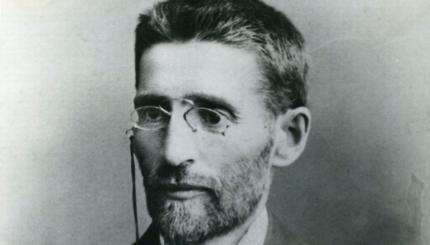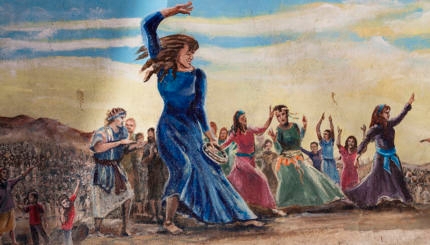The emergence of Hebrew theatre predates the state of Israel by nearly 50 years. The first amateur Hebrew theatre group, called The Lovers of the Hebrew Stage, was active in Palestine from 1904-1914. The first professional Hebrew theatre, Habimah (The Stage), was founded in Moscow in 1917 and won worldwide acclaim with its production of The Dybbuk. Following its international success, Habimah moved to Palestine in 1931, where it became the National Theatre. Just before Habimah’s arrival, actor and director Halevi founded the Ohel Theatre in 1925 as a workers’ theatre dedicated to socialist issues as well as biblical themes. Performing in the land of the Bible, its actors sought to link the once glorious biblical past with their hopes for a Zionist future.
The first Hebrew plays from Palestine tended to focus on pioneering themes. For example, Shin Shalom’s Dan the Guard (1936) and Ahron Ashman’s This Land (1942) both explored the physical and mental hardships suffered by newcomers trying to build a country. Many of the Hebrew plays written at this time depicted relatively harmonious communities, whose major task was to establish roots in the promised land. As was common in American and Canadian pioneering drama, early theatre pieces in Palestine focused on relocating an entire group of characters to a new setting.
Challenges of a New State
After 1948, Israeli theatre began to reflect the realities of life in a new and politically unstable state. At that time, Israeli drama began to explore and portray what would become its two most common motifs: the Holocaust and the Arab-Israeli conflict. These themes have imprinted their marks on Israeli drama since its inception.
 For example, in Moshe Shamir’s He Walked in the Fields (1949), the main character is a young Kibbutznik who has a love affair with a Holocaust survivor but soon after dies in Israel’s War of Independence. The sweeping success of this production was primarily due to the way it evoked Israel’s political andsocial reality. The production also marked the historical and thematic shift between Palestinian Jewish theatre and Israeli theatre. For the first time a sabra (native Israeli) wrote about sabras in an idiomatic and contemporary Hebrew.
For example, in Moshe Shamir’s He Walked in the Fields (1949), the main character is a young Kibbutznik who has a love affair with a Holocaust survivor but soon after dies in Israel’s War of Independence. The sweeping success of this production was primarily due to the way it evoked Israel’s political andsocial reality. The production also marked the historical and thematic shift between Palestinian Jewish theatre and Israeli theatre. For the first time a sabra (native Israeli) wrote about sabras in an idiomatic and contemporary Hebrew.

Help us keep Jewish knowledge accessible to millions of people around the world.
Your donation to My Jewish Learning fuels endless journeys of Jewish discovery. With your help, My Jewish Learning can continue to provide nonstop opportunities for learning, connection and growth.
The 1950s and 1960s
Productions in the 1950s depicted the gap between ideological dreams before the establishment of the state and the following disillusionment. Nissim Aloni, who later became one of Israel’s outstanding playwrights, wrote his Cruelest of All–The King (1953), using the biblical story of the division between Judea and Samaria as a frame for exploring ideological and political divisions within Israeli society. For example, Aloni highlighted Israel’s then problem of choosing whether to side with the United States or the USSR in the Cold War.
Other plays pitted two emerging identities against each other–that of the native Israeli against the Holocaust survivor. Leah Goldberg’s The Lady of the Castle (1955) avoided a direct depiction of Holocaust atrocities and instead reflected upon the cultural brinkmanship of Holocaust survivors. In this play, a Polish man gives the young Jewish protagonist, Lena, a place to hide from the Nazis in his castle. When representatives from the Jewish Agency arrive in Poland looking for survivors after the war, the play centers around Lena’s decision: Should she go with them to Israel or stay with her savior?
Ben Zion Tomer, in his play The Children of the Shadow (1962), described a meeting between Yoram, a young Israeli army officer, with his relative, a former Capo in a concentration camp. Yoram is forced to cope with his own past as a refugee, and re-integrate his oppressed Holocaust childhood into his new, macho Israeli identity.
Modern classics played almost as crucial a rolein Israeli theatre during this time. Samuel Beckett’s Waiting for Godot was frequently staged in Israel, once even as a metaphor for the Palestinians’ endless wait for liberation from the Israeli occupation. Imported drama, which always has a somewhat alienating effect, enabled Israelis to reflect on their own image and achieve some distance from the socio-artistic mirror of original Hebrew theatre.
Beginning in the 1960s, Hanoch Levin began his illustrious writing career. He wrote 56 plays and political satires, providing a major contribution to Israeli theatre including Hefez and The Patriot. Levin usually directed his plays himself and aroused both public scorn and, mostly, critical acclaim for the quality of his plays, many of which traveled abroad.
In 1969 A.B. Yehoshua, primarily a writer of fiction, wrote A Night in May. This play examined Israel’s precarious societal situation in the late 1960s. The plot is located in a small underground Jerusalem apartment, where members of one family display their neuroticism as the Six Day War is about to break out. This piece presented the delicate balance that Israeli theatre maintained between specific local issues and universal human struggles.
Modern Approaches
During the 1970s Israeli theatre became more critical and tried to portray reality in theatrically more forceful and direct ways. In Around and Around (1970), a “Herzl” and a “Kafka” are locked in an asylum together. The playwright, Yossef Mundi, set this scene to compare two extreme images of Israeli identity: the sadistic muscleman (“Herzl”) and the passive, masochistic, and spiritual Jew (“Kafka”). Hillel Mittelpunkt, also in the 1970s, began writing social plays about the down-and-out characters of society.
In the 1980s, Yehoshua Sobol used the stage as a venue for exploring Israeli-Jewish identity issues. In Soul of a Jew (1982), he focused on the self-hatred of Otto Weininger, a turn-of-the-century philosopher who converted from Judaism to Christianity; and in Ghetto (1984) he depicted the Holocaust not just as exclusively Jewish suffering. This play suggested that people must identify their own “Hitler” within, in order to rid themselves of evil.
Contemporary Topics
The 25-year-old Akko Festival for Israeli alternative theatre is perhaps the best example of contemporary Israeli theatrical energy. Presenting about ten out of the 100 submitted entries, the festival handles the “hot topics” in Israeli society–often more accurately than the politicians. In 1985, without deliberate coordination, 11 out of 12 of the major shows in the Festival had “living dead” characters on the stage. Twenty five kilometers further north, the death and destruction of the Lebanon War was still going on. Two years later, in 1987, the artistic director of the festival was accused of presenting an overly political repertoire, because many of the pieces chosen dealt with the low status of the Palestinians in and around the Occupied Areas. Six weeks later the first Intifada broke out.
Despite being highly commercial and insufficiently subsidized, Israeli theatre in the 2000s is nonetheless very much alive. On any given day, about half of the plays showing in Israel are original Hebrew works. Foreign directors often envy the brisk, interesting, and involved atmosphere on Israeli stages and in rehearsal rooms. Each year, more theatre classes are given in Israeli high schools and more theatre teachers are trained. Acting schools have to reject growing numbers of theatre aspirants.
Israeli theatre today spans a vast range of interests and styles: depicting identity crises and thirsting for “universal culture”; bridging antiquity and modernity; importing international drama while adapting stories and Israeli novels.


